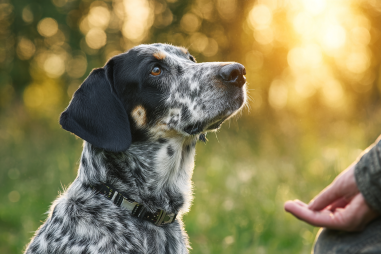Crate training is an essential tool for any dog owner, especially when it comes to breeds like the Bluetick Coonhound. Known for their intelligence, energy, and strong hunting instincts, Bluetick Coonhounds thrive when given structure and a safe space to call their own. Crate training can provide your Bluetick with a secure shelter, aid in housebreaking, and help reduce anxiety during stressful situations. If you’re considering crate training or looking to improve your methods, this step-by-step guide will walk you through everything you need to know to make the process enjoyable and effective for both you and your dog.
Benefits of Crate Training
Crate training offers a range of benefits for Bluetick Coonhounds and their owners. Firstly, it creates a safe, cozy environment where your dog can retreat to when they need rest or feel overwhelmed. This is especially important for a breed like the Bluetick, which is often energetic and curious. By establishing a personal den-like area, your dog gains a sense of security and confidence.
Another key advantage is housebreaking. Dogs naturally avoid soiling their sleeping area, making crate training a highly effective way to teach your Bluetick Coonhound proper bathroom habits. The crate helps control your dog’s movements, minimizing accidents and speeding up the housebreaking process.
In addition, crate training can reduce separation anxiety. Knowing they have a familiar and comforting place to stay while you’re away can decrease stress and destructive behaviors. Lastly, the crate offers a practical solution for safe confinement during travel, vet visits, or times when you cannot supervise your dog directly.
Choosing the Right Crate Size
Selecting the perfect crate size is a crucial step in crate training your Bluetick Coonhound. A crate that’s too small will be uncomfortable and stressful for your dog, while one that’s too large may encourage them to use part of it as a bathroom area.
When shopping for a crate, aim for one that’s just big enough for your Bluetick Coonhound to stand up, turn around, and lie down comfortably. This will typically mean a medium to large-sized crate for this breed, which can weigh between 45 and 80 pounds and measure around 21 to 27 inches at the shoulder.
Adjustable crates or those with dividers can be a great investment, especially for puppies. As your dog grows, you can modify the crate size to maintain comfort and effectiveness. Remember, the goal is to provide a cozy den-like space—not a roomy playpen.
Introducing Your Dog to the Crate
Introducing your Bluetick Coonhound to the crate should be done gradually and positively to build a good relationship with the space. Start by placing the crate in a common area of your home with the door open. Make the crate inviting by adding a soft blanket or bed and placing some favorite toys inside.
Encourage your dog to explore the crate freely by tossing treats or feeding meals near and inside the crate. Avoid forcing your dog inside or shutting the door immediately, as this can create negative associations. Instead, allow your Bluetick to enter and exit on their own terms initially.
Once your dog enters the crate voluntarily and appears comfortable, begin closing the door for short periods while you remain nearby. Gradually increase these intervals as your Bluetick becomes more at ease with the crate’s presence and confinement. This slow introduction process helps prevent fear or anxiety surrounding the crate.
Positive Reinforcement During Training
Positive reinforcement is the cornerstone of successful crate training. Reward-based methods ensure your Bluetick Coonhound associates the crate with pleasant experiences rather than punishment or isolation.
Use treats, praise, and affection each time your dog enters or stays calmly in the crate. Feeding your dog their regular meals inside the crate can further strengthen these positive connections. Additionally, provide chew toys or puzzle feeders to keep your Bluetick entertained while inside.
It’s important to remain patient and consistent throughout the training process. Avoid scolding your dog if they hesitate or resist the crate. Instead, celebrate small successes and move at a pace comfortable for your dog’s personality and temperament.
Troubleshooting Common Problems
While crate training is highly effective, some Bluetick Coonhounds may experience challenges that require troubleshooting. Common issues include barking, whining, or attempts to escape. Understanding the root cause of these behaviors is essential.
- Excessive barking or whining: This often indicates boredom, anxiety, or needing to relieve themselves. Make sure the crate is a stimulating and comfortable space, and avoid leaving your dog crated for too long periods.
- Escape attempts: If your Bluetick tries to claw or chew through the crate, assess whether the crate is sturdy enough and consider adding more exercise and mental enrichment to reduce pent-up energy.
- Reluctance to enter the crate: Revisit introduction steps, use high-value treats, and never force your dog inside. Sometimes changing the crate’s location to a more familiar place can help.
If anxiety persists or worsens, consulting a professional trainer or veterinarian can provide tailored advice and support.
Using the Crate for Travel and Safety
The crate is invaluable when traveling with your Bluetick Coonhound. It ensures your dog’s safety during car trips by preventing distractions and providing a secure space. A crate can also ease your dog’s stress in unfamiliar environments such as hotels or visits to the veterinarian.
When traveling, make sure the crate is securely fastened in the vehicle, well-ventilated, and comfortable for your dog. Bring along familiar bedding and toys to help your Bluetick feel at home while away.
At home, crates serve as a safe space during thunderstorms, fireworks, or other events that might trigger anxiety. Knowing your Bluetick Coonhound has a reliable refuge can give you peace of mind as well.
Making Crate Training a Positive Experience
Crate training your Bluetick Coonhound is a rewarding process that enhances your dog’s well-being and your peace of mind. By choosing the right crate, introducing it patiently, reinforcing positive behavior, and addressing challenges thoughtfully, you can create a trusting and comfortable space for your loyal companion.
Remember that every dog is unique—some may take to crate training quickly, while others may need more time and encouragement. Consistency, patience, and plenty of rewards will help your Bluetick thrive with their new den, making life easier and safer for both of you.






